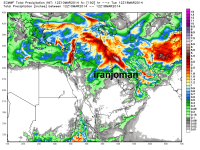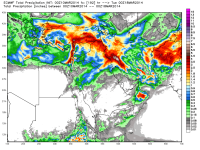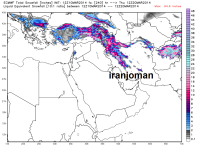-
توجه: در صورتی که از کاربران قدیمی ایران انجمن هستید و امکان ورود به سایت را ندارید، میتوانید با آیدی altin_admin@ در تلگرام تماس حاصل نمایید.
You are using an out of date browser. It may not display this or other websites correctly.
You should upgrade or use an alternative browser.
You should upgrade or use an alternative browser.
مباحث عمومی هواشناسی
- شروع کننده موضوع Amir Mohsen
- تاریخ شروع
- وضعیت
- موضوع بسته شده است.
ecmwf تا 192 ساعت آینده
مشاهده پیوست 54204
اینکه داغونه واسه ما
اینکه داغونه واسه ما
میخوای آپدیت صبح رو بزارم ببینی چقدر داغون بوده!!!
اینکه فاجعه بوده!
این هم آپدیت صبح که از داغونی نمیشه چیزی گفت
مشاهده پیوست 54206
آخه چرا اینطوری شده شمال خراسان امسال !
نواحی کویری مرکز ایران بارششون رو بیشتر زده از سمت ما
Amir Mohsen
متخصص بخش هواشناسی
-
-

Stefan Immler (GSFC) / SWIFT / NASA
2 NASA's Swift satellite captured this high-resolution, ultraviolet view of the Andromeda Galaxy, also known as M31. The mosaic of M31 merges 330 individual images taken by Swift's Ultraviolet/Optical Telescope, spanning an area 200,000 light-years wide.
-

The Hubble Heritage Team / HEIC / ESA / NASA
3 The Cat's Eye Nebula, one of the first planetary nebulae discovered, also has one of the most complex forms known to this kind of nebula. Eleven rings, or shells, of gas surround the nebula's central star, as seen by the Hubble Space Telescope.
-
-
-
-

E. Karkoschka / ESA / NASA
4 The Hubble Space Telescope caught Jupiter's moon Ganymede playing a game of peekaboo. The solar system's biggest moon is shown just before it ducked behind the solar system's biggest planet. Ice-covered Ganymede completes an orbit around Jupiter every seven days.
-

The Hubble Heritage Team , ESA , NASA
5 The Hubble Space Telescope reveals a majestic disk of stars and dust lanes in this view of the spiral galaxy NGC 2841, 46 million light-years away in the constellation Ursa Major. A bright cusp of starlight marks the galaxy's center. Spiraling outward are dust lanes that are silhouetted against the population of whitish middle-aged stars. Much younger blue stars trace the spiral arms.
نروژ تو آپدیت جدیدش برای ما بارش پنج شنبه جمعه رو تقریبا تغییری نداده. بارش یکشنبه و دوشنبه رو زیاد کرده!
http://www.yr.no/place/Iran/Razavi_Khorasan/Dāneshgāh-e_Ferdowsī-ye_Mashhad/long.html
http://www.yr.no/place/Iran/Razavi_Khorasan/Dāneshgāh-e_Ferdowsī-ye_Mashhad/long.html
Amir Mohsen
متخصص بخش هواشناسی
وضعیت آنومالی بارش و دما در سه ماه آینده بر اساس مدل ECMWF


هر چی میگذره واسه منطقه شمال شرق بهتر میشه.بچه ها به نظرتون چند درصد احتمال داره جمعه و 5 شنبه مشهد برف یا بارون خوبی بیاد؟
یکم وضعیت بهتر شده تو آبدیتای امشب
احتمالا مشهد هم بالای 10 میل بارش داشته باشه
Amir Mohsen
متخصص بخش هواشناسی
با توجه به تجربیاتی که در پاییز و زمستان اخیر همه ما کسب کردیم ، می تونیم با اطمینان بالا تحلیل های ارائه شده توسط نظریه پردازان سنتی هواشناسی و اقلیم شناسی در ایران رو به چالش بکشیم چرا که تراف های معکوس دریای سرخ به همراه کم فشار های بریده تراز میانی جو از کم فشار ایسلندی می تونند یکی از دلایل اصلی وقوع بارشهای قابل در جنوبغرب و علی الخصوص زاگرس مرکزی - شرق و غربی باشند.
نا گفته نماند که پر فشار سیبری یا اسیای میانه هم بعنوان یک عامل بلاکینگ باید مثل امسال قدر و جوندار باشه.
نقشه واقعی امروز بعد از ظهر رو ببیند. این الگو به دفعات امسال تکرار شد و اسم مدیترانه خیلی بی دلیل در ایران بزرگ نمایی شده!

نا گفته نماند که پر فشار سیبری یا اسیای میانه هم بعنوان یک عامل بلاکینگ باید مثل امسال قدر و جوندار باشه.
نقشه واقعی امروز بعد از ظهر رو ببیند. این الگو به دفعات امسال تکرار شد و اسم مدیترانه خیلی بی دلیل در ایران بزرگ نمایی شده!

با توجه به تجربیاتی که در پاییز و زمستان اخیر همه ما کسب کردیم ، می تونیم با اطمینان بالا تحلیل های ارائه شده توسط نظریه پردازان سنتی هواشناسی و اقلیم شناسی در ایران رو به چالش بکشیم چرا که تراف های معکوس دریای سرخ به همراه کم فشار های بریده تراز میانی جو از کم فشار ایسلندی می تونند یکی از دلایل اصلی وقوع بارشهای قابل در جنوبغرب و علی الخصوص زاگرس مرکزی - شرق و غربی باشند.
نا گفته نماند که پر فشار سیبری یا اسیای میانه هم بعنوان یک عامل بلاکینگ باید مثل امسال قدر و جوندار باشه.
نقشه واقعی امروز بعد از ظهر رو ببیند. این الگو به دفعات امسال تکرار شد و اسم مدیترانه خیلی بی دلیل در ایران بزرگ نمایی شده!

یک تجربه دیگه هم فکر کنم همه کسب کرده باشن اینه که NAO منفی اصلن واسه ایران خوب نیست هر چند نمیشه ادعا کرد NAO مثبت به تنهایی خوبه!!!

Stefan Immler (GSFC) / SWIFT / NASA
2 NASA's Swift satellite captured this high-resolution, ultraviolet view of the Andromeda Galaxy, also known as M31. The mosaic of M31 merges 330 individual images taken by Swift's Ultraviolet/Optical Telescope, spanning an area 200,000 light-years wide.
The Hubble Heritage Team / HEIC / ESA / NASA
3 The Cat's Eye Nebula, one of the first planetary nebulae discovered, also has one of the most complex forms known to this kind of nebula. Eleven rings, or shells, of gas surround the nebula's central star, as seen by the Hubble Space Telescope.
E. Karkoschka / ESA / NASA
4 The Hubble Space Telescope caught Jupiter's moon Ganymede playing a game of peekaboo. The solar system's biggest moon is shown just before it ducked behind the solar system's biggest planet. Ice-covered Ganymede completes an orbit around Jupiter every seven days.
The Hubble Heritage Team , ESA , NASA
5 The Hubble Space Telescope reveals a majestic disk of stars and dust lanes in this view of the spiral galaxy NGC 2841, 46 million light-years away in the constellation Ursa Major. A bright cusp of starlight marks the galaxy's center. Spiraling outward are dust lanes that are silhouetted against the population of whitish middle-aged stars. Much younger blue stars trace the spiral arms.
اینقدر این تصاویر زیبای نجومی رو اینجا نزار شاید کوچ کردم رفتم بخش نجوم و ستاره شناسی!!!:خنده1:
Solar Update / Moderate Activity
Good morning. Here is an updated look at the visible solar disk on Monday. Solar activity continues at moderate levels. Region 2002 located in the southeast quadrant continued to produce low level M-Flares and a number of minor C-Class flares. The active region continues to maintain a weak delta magnetic signature within the central portion of the group and could produce additional moderate flare activity. In the northern hemisphere, sunspot 1996 remains the other sunspot of interest and is currently producing minor C-Class flares. New sunspots 2003 and 2004 were numbered overnight and are not considered a major threat for solar flares at this time. All other visible regions remain stable or in a state of decay. A couple of coronal mass ejections were observed during the past 24 hours and each appear to be directed away from Earth. One of these events was the result of a solar flare around old region 1986 currently transiting the farside of the sun.
Good morning. Here is an updated look at the visible solar disk on Monday. Solar activity continues at moderate levels. Region 2002 located in the southeast quadrant continued to produce low level M-Flares and a number of minor C-Class flares. The active region continues to maintain a weak delta magnetic signature within the central portion of the group and could produce additional moderate flare activity. In the northern hemisphere, sunspot 1996 remains the other sunspot of interest and is currently producing minor C-Class flares. New sunspots 2003 and 2004 were numbered overnight and are not considered a major threat for solar flares at this time. All other visible regions remain stable or in a state of decay. A couple of coronal mass ejections were observed during the past 24 hours and each appear to be directed away from Earth. One of these events was the result of a solar flare around old region 1986 currently transiting the farside of the sun.
seyyedalireza
مدیر موقت
سلام اپدیت ها خوب شده
من که گفنم اسممو عوض میکنم اگه مشهد بارش خوبی نداشته باشه
خدا عنایت کرد تا ما اسممون رو عوض نکنیم
انشالله اپ های بعدی بهتر باشه
من که گفنم اسممو عوض میکنم اگه مشهد بارش خوبی نداشته باشه
خدا عنایت کرد تا ما اسممون رو عوض نکنیم
انشالله اپ های بعدی بهتر باشه
- وضعیت
- موضوع بسته شده است.










